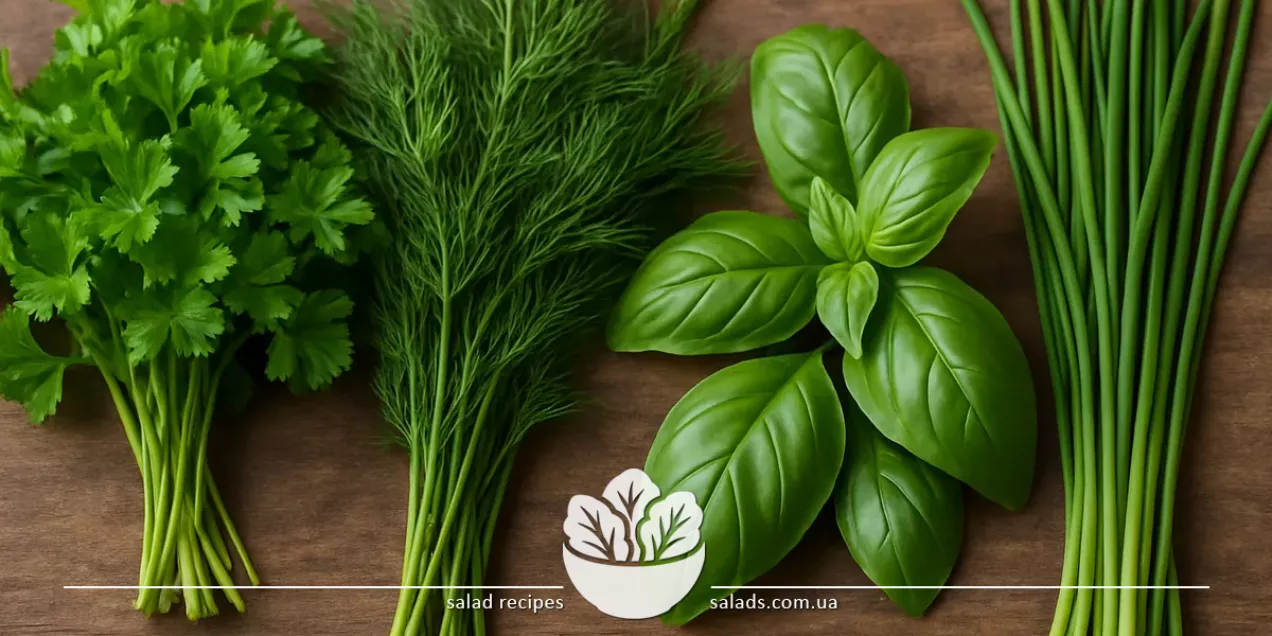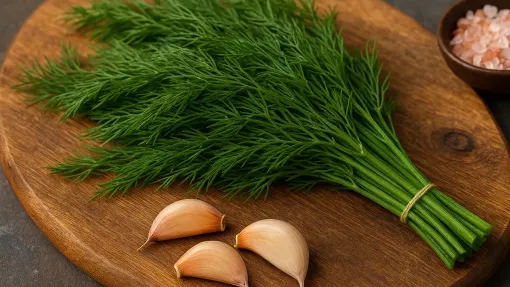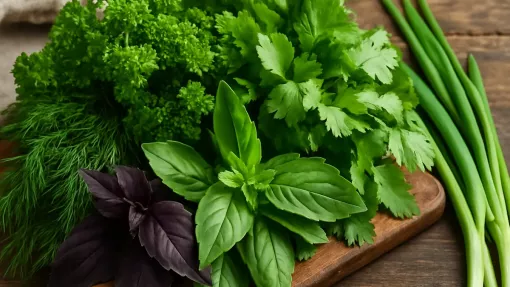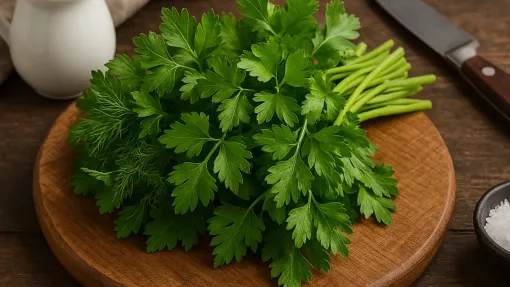Types of Herbs

Types of herbs offer a variety of culinary nuances that form the aromatic base of many dishes. Herbs can be savory, delicate, bold, or versatile – they are added to salads, soups, sauces, sides, meat, and fish dishes. Dill, parsley, cilantro, basil, green onions, oregano, and mint are just a few of the many options that pair well with vegetables, meat, cheese, and grains. Learn more about other vegetables in the vegetables category.
Different Kinds of Herbs
Parsley, Dill, Cilantro: Everyday Kitchen Essentials
Parsley is one of the most versatile herbs, found in nearly every cuisine. There are two main types – leaf parsley and root parsley. Leaf parsley has a bright but mild aroma, perfectly complementing soups, salads, meat dishes, and marinades. It is often used as a finishing touch before serving. Root parsley provides not only leaves but also a fragrant root that is added to broths and sauces. Dill is another common herb with a fresh, slightly sweet, and easily recognizable scent. It is added to sautéed vegetables, fish dishes, soups, and cream-based sauces. Dill pairs especially well with new potatoes, eggs, and fish. In pickling cucumbers or cabbage, dill serves not only as a flavoring but also as a natural preservative.
Cilantro (Chinese parsley) is a herb with a very bold, even pungent aroma. It is used in many Asian, Caucasian, and Latin American recipes. It goes well with spicy sauces, meat dishes, vegetables, and legumes. Unlike parsley and dill, cilantro should be added with care due to its intense flavor. Herbs work well with vegetables in salads and sides. For example, cilantro or parsley can be added to tomatoes, forming a classic base for fresh summer salads, salsas, dressings, and appetizers.
Basil, Oregano, Mint: Aromatic Herbs in Global Cuisines
Aromatic herbs are used not only for flavoring but also to create a distinctive culinary atmosphere. Basil is one of the most popular herbs in this group. It has a sweet, fresh, and slightly spicy aroma that shines in Mediterranean cuisine. Green basil is the base for pesto, pizza, pasta, and salads. Purple basil has a stronger aroma and is often used in dishes with Eastern or Caucasian influence. Oregano is a savory herb with a slightly bitter, earthy flavor. It is often used in dried form, but fresh oregano is also added to vegetable stews, sauces, marinades, and meat dishes. In Greek and Italian cooking, oregano is used in salads, pizza, and tomato sauces.
Mint is an herb with a bright, cooling aroma. It is added not only to desserts and drinks but also to meat dishes, sauces, legumes, and vegetable salads. Mint pairs especially well with dairy products – for example, in yogurt-based sauces or cold summer soups. It adds freshness and balances strong flavors. These aromatic herbs pair wonderfully with cucumbers. For instance, mint and cucumber are often combined in salads or cold appetizers, oregano is used in cucumber marinades, and basil – in light vegetable dishes with fresh cucumbers.
Herbs in Salads, Soups, Sides, and Sauces
Herbs bring freshness and vibrant flavor to salads, highlight ingredients, and enhance aroma. Green salads often combine several types of herbs – parsley, dill, basil, arugula, and cilantro. Such mixes enrich dishes with vitamins and textures. Herbs pair especially well with vegetables, cheeses, eggs, and meats. For example, parsley and dill are a classic duo for summer salads, while basil and arugula give dishes a Mediterranean character. In soups, herbs are used at different stages: for making broth, as a purée, or as a fresh addition before serving. Dill, parsley, and green onions are traditional bases for green borscht, vegetable, and chicken soups. Aromatic herbs like mint or basil are often added to legume-based soups or purées to enhance aroma.
In side dishes, herbs serve not only as garnish but also as a flavor component. They are added to steamed vegetables, potatoes, grains, and legumes, bringing freshness and balance. Roasted vegetables with a fresh herb-based sauce are one of the best ways to diversify everyday meals. Herbs are also added to skillet dishes as a finishing touch. Sauces with herbs form a separate category of culinary creations. Pesto, chutney, green tahini, and sauces based on sour cream, yogurt, or butter with herbs – these are just a few examples of how even a small amount of herbs can dramatically transform a dish. These sauces pair especially well with cabbage – in salads, burgers, or as side dishes.
Herbs Around the World: Regional Culinary Uses
In different parts of the world, herbs have specific meanings and culinary roles. In Mediterranean cuisine, basil, oregano, mint, and rosemary prevail – they are added to tomato sauces, fish, pasta, and salads. Greek salad wouldn’t be complete without oregano, and pizza – without basil. Mint is frequently used in Middle Eastern dishes: tabbouleh salads, yogurt-based sauces, and pie fillings. In Caucasian and Central Asian cuisine, herbs are served alongside meals as a distinct element – dill, parsley, basil, cilantro, and green onions are served with meat, soups, and kebabs. Herbs are often used in large quantities – not just as a seasoning but as a primary ingredient. For example, in soups, pies, or dough-based dishes, herbs play a leading role.
In Indian cuisine, herbs are mainly used in the form of mint, coriander leaves, and sometimes fennel. They are added to chutneys, curries, rice, and legume dishes. Chinese cuisine uses garlic sprouts, green onions, watercress, and other local herbs – both raw and cooked. In Vietnamese and Thai cuisines, herbs are common in pho soups, rice dishes, and salads. Herbs pair particularly well with onions – in salads, sides, appetizers, and soups. Both ingredients have strong yet distinct aromas that add depth and complexity to even the simplest meals.
How to Choose, Store, and Use Fresh Herbs
To keep herbs fragrant and fresh, it’s important to select them properly. Leaves should be bright green, without spots, yellowing, or wilting. Stems should be firm, unbroken, and not overly moist. Herbs that are too wet or slippery to the touch are not suitable for consumption. The best choice is to buy herbs in bunches or pots if they are intended for long-term use. Store herbs in the refrigerator, wrapped in a paper towel and placed in a plastic bag with small holes. You can also place them in a glass of water and cover with a bag. It is not recommended to wash herbs in advance – it's best to do it just before use to avoid spoilage. The only exception is for herbs prepared for freezing or drying.
Before adding to a dish, herbs should be rinsed thoroughly under cold water and patted dry. Chop them right before serving or finishing the dish to preserve aroma. Some herbs (like basil or mint) don’t tolerate prolonged contact with a knife – it's better to tear them by hand. Herbs are often used as a final ingredient, but some types (such as dill or parsley) can be boiled, fried, or stewed. A great example of a dish with lots of herbs is a salad with sweet peppers – colorful, fresh, and aromatic. In such combinations, herbs not only enhance the flavor but also make the dish more nutritious and appealing.


